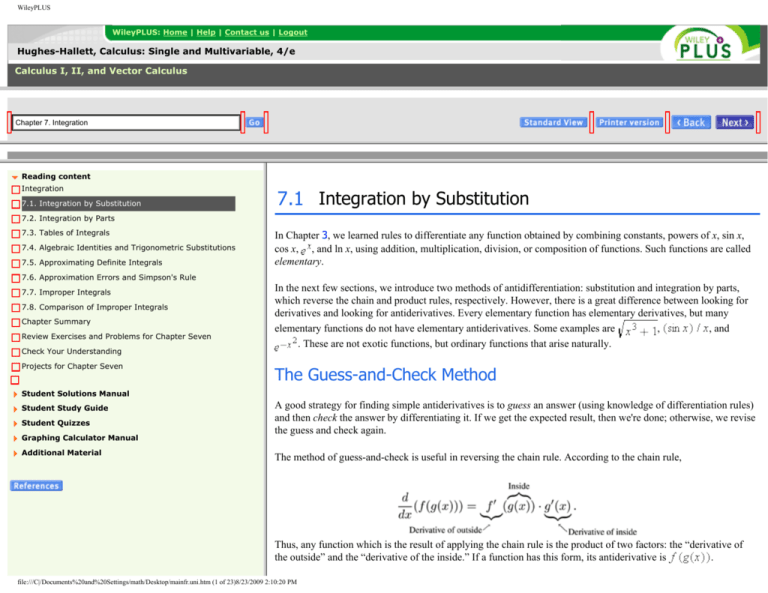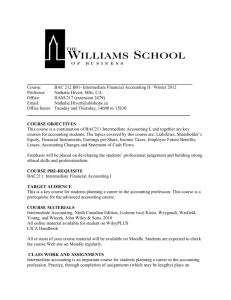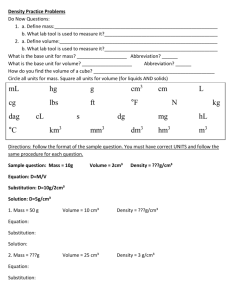
WileyPLUS
WileyPLUS: Home | Help | Contact us | Logout
Hughes-Hallett, Calculus: Single and Multivariable, 4/e
Calculus I, II, and Vector Calculus
Chapter 7. Integration
Reading content
Integration
7.1. Integration by Substitution
7.1 Integration by Substitution
7.2. Integration by Parts
7.3. Tables of Integrals
7.4. Algebraic Identities and Trigonometric Substitutions
7.5. Approximating Definite Integrals
In Chapter 3, we learned rules to differentiate any function obtained by combining constants, powers of x, sin x,
cos x, , and ln x, using addition, multiplication, division, or composition of functions. Such functions are called
elementary.
7.6. Approximation Errors and Simpson's Rule
7.7. Improper Integrals
7.8. Comparison of Improper Integrals
Chapter Summary
Review Exercises and Problems for Chapter Seven
Check Your Understanding
Projects for Chapter Seven
In the next few sections, we introduce two methods of antidifferentiation: substitution and integration by parts,
which reverse the chain and product rules, respectively. However, there is a great difference between looking for
derivatives and looking for antiderivatives. Every elementary function has elementary derivatives, but many
elementary functions do not have elementary antiderivatives. Some examples are
,
, and
. These are not exotic functions, but ordinary functions that arise naturally.
The Guess-and-Check Method
Student Solutions Manual
Student Study Guide
Student Quizzes
Graphing Calculator Manual
Additional Material
A good strategy for finding simple antiderivatives is to guess an answer (using knowledge of differentiation rules)
and then check the answer by differentiating it. If we get the expected result, then we're done; otherwise, we revise
the guess and check again.
The method of guess-and-check is useful in reversing the chain rule. According to the chain rule,
Thus, any function which is the result of applying the chain rule is the product of two factors: the “derivative of
.
the outside” and the “derivative of the inside.” If a function has this form, its antiderivative is
file:///C|/Documents%20and%20Settings/math/Desktop/mainfr.uni.htm (1 of 23)8/23/2009 2:10:20 PM
WileyPLUS
Example 1
Find
.
Solution
The function
looks like the result of applying the chain rule: there is an “inside” function
and its
derivative
appears as a factor. Since the outside function is a cosine which has a sine as an antiderivative, we
guess
for the antiderivative. Differentiating to check gives
Since this is what we began with, we know that
The basic idea of this method is to try to find an inside function whose derivative appears as a factor. This works
even when the derivative is missing a constant factor, as in the next example.
Example 2
Find
.
Solution
is an inside function. So we guess
for the antiderivative, since taking the derivative
It looks like
of an exponential results in the reappearance of the exponential together with other terms from the chain rule.
Now we check:
The original guess was too large by a factor of 2. We change the guess to
file:///C|/Documents%20and%20Settings/math/Desktop/mainfr.uni.htm (2 of 23)8/23/2009 2:10:20 PM
and check again:
WileyPLUS
Thus, we know that
Example 3
Find
Solution
, and its derivative appears as a factor, with the exception of a missing 4. Thus,
Here the inside function is
the integrand we have is more or less of the form
. Since
with
an antiderivative is
is an antiderivative of the outside function
Let's check and see:
so
Thus
As a final check:
file:///C|/Documents%20and%20Settings/math/Desktop/mainfr.uni.htm (3 of 23)8/23/2009 2:10:20 PM
is too big by a factor of 4. The correct antiderivative is
, we might guess that
WileyPLUS
As we have seen in the preceding examples, antidifferentiating a function often involves “correcting for” constant
factors: if differentiation produces an extra factor of 4, antidifferentiation will require a factor of
.
The Method of Substitution
When the integrand is complicated, it helps to formalize this guess-and-check method as follows:
To Make a Substitution
Let w be the “inside function” and
.
Let's redo the first example using a substitution.
Example 4
Find
.
Solution
As before, we look for an inside function whose derivative appears—in this case . We let
. Then
. The original integrand can now be completely rewritten in terms of the new
variable w:
By changing the variable to w, we can simplify the integrand. We now have
, which can be
antidifferentiated more easily. The final step, after antidifferentiating, is to convert back to the original variable, x.
Why Does Substitution Work?
The substitution method makes it look as if we can treat
and
as separate entities, even canceling them in
. Let's see why this works. Suppose we have an integral of the form
the equation
, where
file:///C|/Documents%20and%20Settings/math/Desktop/mainfr.uni.htm (4 of 23)8/23/2009 2:10:20 PM
is the inside function and
is the outside function. If F is an
WileyPLUS
antiderivative of f, then
Now write
, and by the chain rule
and
On the other hand, knowing that
. Therefore,
on both sides of this equation:
tells us that
Thus, the following two integrals are equal:
leaves the indefinite integral unchanged.
Substituting w for the inside function and writing
Let's revisit the second example that we did by guess-and-check.
Example 5
Find
.
Solution
Here the inside function is
try
, with derivative
. Since there is a factor of t in the integrand, we
Then
Notice, however, that the original integrand has only
and then substitute:
file:///C|/Documents%20and%20Settings/math/Desktop/mainfr.uni.htm (5 of 23)8/23/2009 2:10:20 PM
, not
. We therefore write
WileyPLUS
This gives the same answer as we found using guess-and-check.
Why didn't we put
in the preceding example? Since the constant C is arbitrary, it
doesn't really matter whether we add C or
. The convention is always to add C to whatever antiderivative we
have calculated.
Now let's redo the third example that we solved previously by guess-and-check.
Example 6
Find
.
Solution
The inside function is
, with derivative
missing is a constant factor, we try
. The integrand has a factor of
Then
giving
Thus,
Once again, we get the same result as with guess-and-check.
file:///C|/Documents%20and%20Settings/math/Desktop/mainfr.uni.htm (6 of 23)8/23/2009 2:10:20 PM
, and since the only thing
WileyPLUS
Warning
We saw in the preceding examples that we can apply the substitution method when a constant factor is missing
from the derivative of the inside function. However, we may not be able to use substitution if anything other
than a constant factor is missing. For example, setting
to find
is not a constant multiple of
. Substitution works if the integrand
does us no good because
contains the derivative of the inside function, to within a constant factor.
Some people prefer the substitution method over guess-and-check since it is more systematic, but both methods
achieve the same result. For simple problems, guess-and-check can be faster.
Example 7
Find
.
Solution
We let
gives
so
Thus
file:///C|/Documents%20and%20Settings/math/Desktop/mainfr.uni.htm (7 of 23)8/23/2009 2:10:20 PM
since its derivative is
and there is a factor of
in the integrand. This
WileyPLUS
Example 8
Find
.
Solution
Observing that the derivative of
Since the numerator is
is
, we see
, we might also have tried
is a good choice. Then
, so that
. This substitution leads to the integral
, which is better than the original integral but requires another substitution,
finish. There are often several different ways of doing an integral by substitution.
Notice the pattern in the previous example: having a function in the denominator and its derivative in the
numerator leads to a natural logarithm. The next example follows the same pattern.
Example 9
Find
.
Solution
Recall that
. If
, then
Definite Integrals by Substitution
file:///C|/Documents%20and%20Settings/math/Desktop/mainfr.uni.htm (8 of 23)8/23/2009 2:10:20 PM
, so
, to
WileyPLUS
Example 10
Compute
Solution
To evaluate this definite integral using the Fundamental Theorem of Calculus, we first need to find an
antiderivative of
. The inside function is
, so we let
. Then
, so
. Thus,
Now we find the definite integral
There is another way to look at the same problem. After we established that
our next two steps were to replace w by , and then x by 2 and 0. We could have directly replaced the original
and
, by the corresponding w limits. Since
, the w limits are
limits of integration,
(when
) and
(when
), so we get
As we would expect, both methods give the same answer.
file:///C|/Documents%20and%20Settings/math/Desktop/mainfr.uni.htm (9 of 23)8/23/2009 2:10:20 PM
WileyPLUS
To Use Substitution to Find Definite Integrals
Either
•
Compute the indefinite integral,
expressing an antiderivative in terms of
the original variable, and then evaluate
the result at the original limits,
or
•
Convert the original limits to new limits
in terms of the new variable and do not
convert the antiderivative back to the
original variable.
Example 11
Evaluate
.
Solution
and
To use substitution, we must decide what w should be. There are two possible inside functions,
Now
and since the integral contains a factor of
. When
,
file:///C|/Documents%20and%20Settings/math/Desktop/mainfr.uni.htm (10 of 23)8/23/2009 2:10:20 PM
but not of
, and when
, we try
. Then
, so
.
WileyPLUS
Example 12
Evaluate
.
Solution
Let
, so
. When
Notice that we write the limit
corresponds to the lower limit
,
, and when
,
at the bottom, even though it is larger than
.
, so
, because
More Complex Substitutions
In the examples of substitution presented so far, we guessed an expression for w and hoped to find
(or some
constant multiple of it) in the integrand. What if we are not so lucky? It turns out that it often works to let w be
some messy expression contained inside, say, a cosine or under a root, even if we cannot see immediately how
such a substitution helps.
Example 13
Find
.
Solution
This time, the derivative of the inside function is nowhere to be seen. Nevertheless, we try
, so
file:///C|/Documents%20and%20Settings/math/Desktop/mainfr.uni.htm (11 of 23)8/23/2009 2:10:20 PM
. Therefore
. We have
. Then
WileyPLUS
Notice that the substitution in the preceding example again converts the inside of the messiest function into
something simple. In addition, since the derivative of the inside function is not waiting for us, we have to solve for
entirely in terms of w and
.
x so that we can get
Example 14
Find
.
Solution
Here, instead of the derivative of the inside function (which is −2), we have the factor
turns out to help anyway. Then
, so
substituting
. If
, then
, so
convert everything to w, including
in terms of w. Thus
therefore we can write
Looking back over the solution, the reason this substitution works is that it converts
of the integrand, to
, which can be combined with the other term and then integrated.
Exercises and Problems for Section 7.1
Click here to open Student Solutions Manual: Ch 07 Section 01
file:///C|/Documents%20and%20Settings/math/Desktop/mainfr.uni.htm (12 of 23)8/23/2009 2:10:20 PM
. However,
. Now we must
, and
, the messiest part
WileyPLUS
Click here to open Web Quiz Ch 07 Section 01
Exercises
1. Use substitution to express each of the following integrals as a multiple of
Then evaluate the integrals.
(a).
(b).
2.
(a). Find the derivatives of
and
.
(b). Use your answer to part (a) to find antiderivatives of:
(i).
(ii).
(c). Find the general antiderivatives of:
(i).
(ii).
Find the integrals in Exercises 3–44. Check your answers by differentiation.
3.
4.
5.
file:///C|/Documents%20and%20Settings/math/Desktop/mainfr.uni.htm (13 of 23)8/23/2009 2:10:20 PM
for some a and b.
WileyPLUS
6.
7.
8.
9.
10.
11.
12.
13.
14.
15.
16.
17.
18.
file:///C|/Documents%20and%20Settings/math/Desktop/mainfr.uni.htm (14 of 23)8/23/2009 2:10:20 PM
WileyPLUS
19.
20.
21.
22.
23.
24.
25.
26.
27.
28.
29.
30.
31.
file:///C|/Documents%20and%20Settings/math/Desktop/mainfr.uni.htm (15 of 23)8/23/2009 2:10:20 PM
WileyPLUS
32.
33.
34.
35.
36.
37.
38.
39.
40.
41.
42.
43.
file:///C|/Documents%20and%20Settings/math/Desktop/mainfr.uni.htm (16 of 23)8/23/2009 2:10:20 PM
WileyPLUS
44.
For the functions in Exercises 45–52, find the general antiderivative. Check your answers by differentiation.
45.
46.
47.
48.
49.
50.
51.
52.
For Exercises 53–60, use the Fundamental Theorem to calculate the definite integrals.
53.
54.
55.
56.
file:///C|/Documents%20and%20Settings/math/Desktop/mainfr.uni.htm (17 of 23)8/23/2009 2:10:20 PM
WileyPLUS
57.
58.
59.
60.
For Exercises 61–66, evaluate the definite integrals. Whenever possible, use the Fundamental Theorem of
Calculus, perhaps after a substitution. Otherwise, use numerical methods.
61.
62.
63.
64.
65.
66.
Find the integrals in Exercises 67–74.
file:///C|/Documents%20and%20Settings/math/Desktop/mainfr.uni.htm (18 of 23)8/23/2009 2:10:20 PM
WileyPLUS
67.
68.
69.
70.
71.
72.
73.
74.
Problems
75. If appropriate, evaluate the following integrals by substitution. If substitution is not appropriate, say so, and
do not evaluate.
file:///C|/Documents%20and%20Settings/math/Desktop/mainfr.uni.htm (19 of 23)8/23/2009 2:10:20 PM
WileyPLUS
(a).
(b).
(c).
(d).
(e).
(f).
76. Suppose
. Calculate the following:
(a).
(b).
77. Suppose
(a).
(b).
(c).
78.
file:///C|/Documents%20and%20Settings/math/Desktop/mainfr.uni.htm (20 of 23)8/23/2009 2:10:20 PM
. Calculate the following:
WileyPLUS
(a).
Calculate exactly:
(b). Calculate the exact area under the curve
between
and
.
79. Use the Fundamental Theorem to find the area under the graph of
.
80. Find the exact area under the graph of
between
between
and
.
81. Find the exact value of the area under one arch of the curve
82. Find the exact average value of
showing the function and the average value.
83. Find
, where
on the interval
and
to
and
.
. Sketch a graph
using two methods:
(a). Do the multiplication first, and then antidifferentiate.
(b). Use the substitution
.
(c). Explain how the expressions from parts (a) and (b) are different. Are they both correct?
84.
(a).
Find
.
(b). You probably solved part (a) by making the substitution
it that way.) Now find
or
. (If not, go back and do
by making the other substitution.
(c). There is yet another way of finding this integral which involves the trigonometric identities
Find
file:///C|/Documents%20and%20Settings/math/Desktop/mainfr.uni.htm (21 of 23)8/23/2009 2:10:20 PM
using one of these identities and then the substitution
.
WileyPLUS
(d).
You should now have three different expressions for the indefinite integral
. Are they
really different? Are they all correct? Explain.
85. Let
for constant m, n. Show that
.
86. If t is in years since 1990, the population, P, of the world in billions can be modeled by
.
(a). What does this model give for the world population in 1990? In 2000?
(b). Use the Fundamental Theorem to find the average population of the world during the 1990s.
87. Oil is leaking out of a ruptured tanker at the rate of
(a). At what rate, in liters per minute, is oil leaking out at
thousand liters per minute.
? At
?
(b). How many liters leak out during the first hour?
88. Throughout much of the 20th century, the yearly consumption of electricity in the US increased
exponentially at a continuous rate of 7% per year. Assume this trend continues and that the electrical energy
consumed in 1900 was 1.4 million megawatt-hours.
(a). Write an expression for yearly electricity consumption as a function of time, t, in years since 1900.
(b). Find the average yearly electrical consumption throughout the 20th century.
(c). During what year was electrical consumption closest to the average for the century?
(d). Without doing the calculation for part (c), how could you have predicted which half of the century the
answer would be in?
89. If we assume that wind resistance is proportional to velocity, then the downward velocity, v, of a body of
mass m falling vertically is given by
where g is the acceleration due to gravity and k is a constant. Find the height, h, above the surface of the earth as a
function of time. Assume the body starts at height .
90. If we assume that wind resistance is proportional to the square of velocity, then the downward velocity, v, of
a falling body is given by
file:///C|/Documents%20and%20Settings/math/Desktop/mainfr.uni.htm (22 of 23)8/23/2009 2:10:20 PM
WileyPLUS
to find the height, h, of the body above the surface of the earth as a
Use the substitution
function of time. Assume the body starts at a height .
91.
(a). During the 1970s, ACME Widgets sold at a continuous rate of
widgets per year, where t is
time in years since January 1, 1970. Suppose they were selling widgets at a rate of 1000 per year on the
first day of the decade. How many widgets did they sell during the decade? How many did they sell if the
rate on January 1, 1970 was 150,000,000 widgets per year?
(b). In the first case above (1000 widgets per year on January 1, 1970), how long did it take for half the
widgets in the 1970s to be sold? In the second case (150,000,000 widgets per year on January 1, 1970),
when had half the widgets in the 1970s been sold?
(c). In 1980 ACME began an advertising campaign claiming that half the widgets it had sold in the previous
ten years were still in use. Based on your answer to part (b), about how long must a widget last in order to
justify this claim?
Copyright © 2006 John Wiley & Sons, Inc. All rights reserved.
file:///C|/Documents%20and%20Settings/math/Desktop/mainfr.uni.htm (23 of 23)8/23/2009 2:10:20 PM






